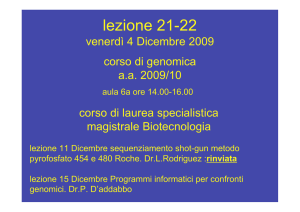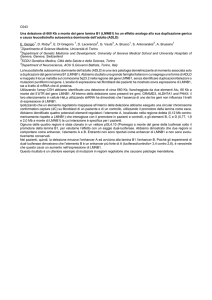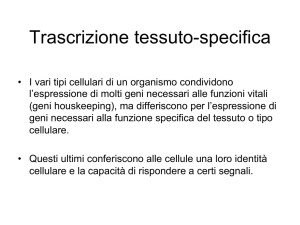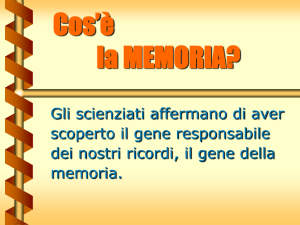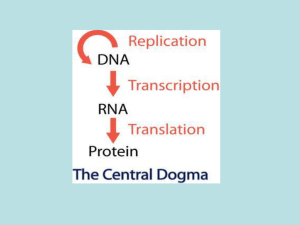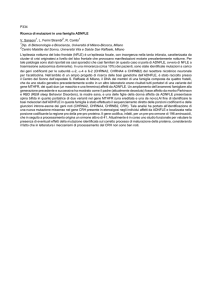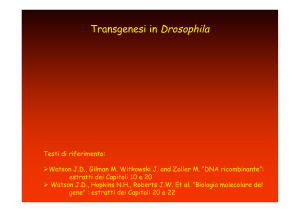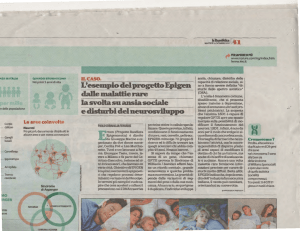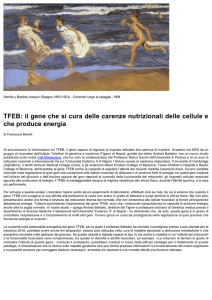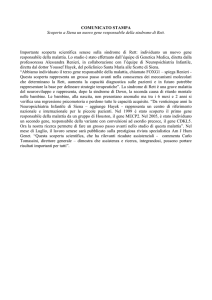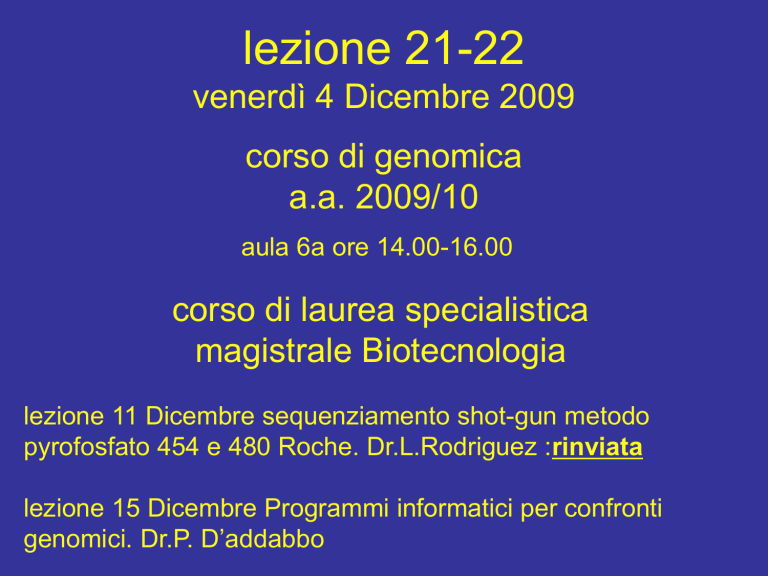
lezione 21-22
venerdì 4 Dicembre 2009
corso di genomica
a.a. 2009/10
aula 6a ore 14.00-16.00
corso di laurea specialistica
magistrale Biotecnologia
lezione 11 Dicembre sequenziamento shot-gun metodo
pyrofosfato 454 e 480 Roche. Dr.L.Rodriguez :rinviata
lezione 15 Dicembre Programmi informatici per confronti
genomici. Dr.P. D’addabbo
Genomic views of distant-acting enhancers
Axel Visel, Edward M. Rubin & Len A. Pennacchio; Nature vol 461, 10 Sept. 09; 199-205
In contrast to protein-coding sequences, the significance of
variation in non-coding DNA in human disease has been
minimally explored. A great number of recent genome-wide
association studies suggest that noncoding variation is a
significant risk factor for common disorders, but the
mechanisms by which this variation contributes to disease
remain largely obscure. Distant-acting transcriptional
enhancers — a major category of functional non-coding DNA
— are involved in many developmental and disease-relevant
processes. Genomewide approaches to their discovery and
functional characterization are now available and provide a
growing knowledge base for the systematic exploration of their
role in human biology and disease susceptibility.
functional non coding DNA
first associations from WGA and human pathologies of
variants of non coding seq.
es: 58kb linkage diseq.w/o prot.coding genes crms 9p21
risk for coronary artery disease far 60kb from the first
coding gene
meta-analysis of ~1200 SNPs most significantly assoc in WGA
analyses published within March 5th 2009
con sovrastima di LD (per non perdere info.) 472 /1170 regioni
non hanno sovrapposizione con esoni o SNPs linked
più di un terzo di seq. non codif. hanno varianti assoc. a
patologie o ai fenotipi della ricerca WGA (qui WGAS)
spiegazione: elementare Watson
andiamo a finire sullo stesso carugio:
one possibility that could explain these GWAS hits is that the
non-coding intervals contain enhancers, a category of gene
regulatory sequence that can act over long distances. A
simplified view of the current understanding of the role of
enhancers in regulating genes is summarized in Fig. 1.
ma oltre a questo stanno tutte le altre cose che abbiamo già
dette a proposito della conformazione-architettura variabile
della cromatina, posizionamento ed epigenetica che sono
fortemente influenzate dalle varianti alleliche
ci sarà un secondo codice genetico?
insulators and silencers
isolatori
e
silenziatori
The docking of RNA polymerase II to proximal promoter
sequences and transcription initiation are fairly well
characterized; by contrast, the mechanisms by which
insulator and silencer elements buffer or repress gene
regulation, respectively, are less well understood.
Transcriptional enhancers are regulatory sequences that can
be located upstream of, downstream of or within their target
gene and can modulate expression independently of their
orientation.
In vertebrates, enhancer sequences comprise clustered
aggregations of transcription-factor-binding sites. When
appropriate occupancy of transcription-factor-binding sites
is achieved, recruitment of transcriptional coactivators and
chromatin remodelling proteins occurs.
rimodellamento - looping
l’aggregato cromatina proteine risultante (probabilmente
liberando i nucleosomi) facilita il looping e attivazione del
gene mediata dal promotore
molti geni regolati da serie di enhancers ognuno con compiti
diversi per il pattern di espressione dei mRNA (i cui effetti
additivi visti anche su geni eterologhi e geni reporter).
GWAS non possono mostrare i meccanismi molecolare (solo
identificare le regioni)
Studi successivi dei singoli loci mostrano cambiamenti di
funzione dei diversi alleli di enhancer attivi a distanza e
associazione a patologie
- analisi delle strategie per trovare i siti e le funzioni su tutto il
genoma
ipotesi su malattie e regioni non codificanti
It is often less recognized that in addition to the integrity of
the protein-coding sequences, human health critically also
depends on the spatially, temporally, and quantitatively
correct expression of those genes
Genetic disease could equally be caused by disruption of
the regulatory mechanisms that ensure proper gene
expression. The term “position effect” is used in those
situations where the expression level of a gene is
deleteriously affected by an alteration in its chromosomal
environment, while maintaining an intact transcription unit.
WGAS found many regions without codifying exons.
Long-Range Gene Control and Genetic Disease Advances in Genetics
Volume 61, 2008, Pages 339-388 Dirk A. Kleinjana and Laura A. Letticea
metodi iniziali
ci possono essere malattie associate a regioni regolative?
prime evidenze nelle talassemie scoperte nei riarrangiamenti
che mostravano solo mutazioni in regioni non codificanti
(c’erano già evidenze di traslocazioni nei linfomi di Burkitt
con enhancer delle Ig14q32 e c-myc 8q24 = 8/14) ricordatevi dei
chrms territories e del perchè delle traslocazioni ricorrenti.
Esempio classico è quello mostrato in Figura 1
enhancers in human diseases
tre esempi:
- delez. e riarrang. degli enhancers della globina
HBB (hum beta globin)
- mutaz. dell’enhancer Sonic Hedgehog HGG limb
(provoca polidattilia)
- suscettibilità alla malattia di Hirschsprung
associata alla variante allelica dell’ enhancer di
RET (protoncogene)
models of enhancer long distance functioning
sito diverso
di attacco dei fattori
di trascrizione
- del SNC (blu)
- degli abbozzi
degli arti (verde)
legend to figure 1
Overview of gene regulation by distant-acting enhancers.
l’azione regolativa di un promotore per molti geni non è sufficiente per un
pattern di espressione complesso:espressione di un gene “G” in due tessuti
diversi durante le fasi di sviluppo embrionale (ZRS o MFCS1 di SHH)
“Amano and colleagues report that expression of Sonic hedgehog (Shh)
protein in the posterior mesenchyme of the mouse limb bud correlates with a
long-range chromatin interaction with enhancer MFCS1 and looping of the
Shh locus from its chromosome territory (CT).”
a) in rosso espressione di G negli abbozzi degli arti e nel SNC
b) modello: enhancer blu può legare una combinazione di alcuni
fatt. di trascriz. se al completo l’enhancer si attiva (ricollocano
l’enhancer fisicamente vicino al promotore (con un “loop”)
c) enhancer verde legato da una combinazione diversa di fattori
di trascrizione specifici per il tessuto “c”, solo quando si legano
parte l’attività tessuto specifica di questo secondo enhancer
parte II della leggenda alla fig.1
come è possibile che due enhancers regolino lo stesso
promotore ?
a) tramite fattori di trascrizione tessuto specifici
b) tramite “insulators” che limitano l’attività a domini
cromosomici definiti
c) oltre agli enhancer (regolazione positiva) ci sono
repressori “repressors” e silenziatori “silencers” che
partecipano alla regolazione trascrizionale (negativa).
distanza degli enhancers
nel caso di MFCS1 o ZRS sta 1 mega base da SHH dentro
un introne di un gene limitrofo,
- inizialmente considerato rilevante per gli abbozzi degli arti e
fu chiamato LMBR1 (limb region)
- studi successivi di topo e uomo: risequenziamento (single
nucleotide variations) associazione con polidattilia preassiale,
segrega in famiglie con anormalità degli arti
- topi transgenici per sostituzione di nucleotide singolo hanno
come nei gatti un dito preassiale soprannumerario
- delezione dell’enhancer provoca arti tronchi
questi studi hanno mostrato per la prima volta
sperimentalmente l’importanza di sequenze non codificanti
che agiscono a grande distanza da cui studi sull’uomo
polidattilia o arti tronchi
Hirschsprung disease
altro esempio di mutazioni in regioni non codificanti
Although multigenic, Hirschsprung’s disease risk is strongly
linked to coding mutations in the RET proto-oncogene.
However, family-based studies have also revealed evidence
for Hirschsprung’s disease linked to the RET locus in people
lacking any accompanying functional RET coding mutations.
Through the use of multispecies comparisons of orthologous
genomic intervals that include and flank RET, coupled with in
vitro and in vivo functional studies, an enhancer sequence
located in intron 1 of RET was identified and found to contain
a common variant contributing more than a 20-fold increased
risk for Hirschsprung’s disease than rarer alleles in this
element. It is not sufficient since the disease is multifactorial
and with complex aetiology.
enhancers in malattie rare o comuni ?
le patologie associate a varianti o polimorfismi di
enhancers sono frequenti o rare ?
- a rapidly growing number of examples in which noncoding SNPs
linked to disease traits through GWAS were found to affect the
expression levels of nearby genes, suggesting that variation in
regulatory sequences may commonly contribute to a wide range of
disorders.
The results of the recent GWAS, coupled with the role of gene
regulation in normal human biology, provide a strong incentive for
defining the distant-acting-enhancer architecture of the human
genome.
come trovare gli enhancers e regulatory
regions RR
Gene centric studies gave limited results
Large scale studies through comparative genomics
- assumption: sequences of gene regulatory elements, like
those of protein-coding genes, are under negative
evolutionary selection, because most changes in functional
sequences have deleterious consequences.
Statistical measures of evolutionary sequence constraint
would provide a way to identify potential enhancer sequences
within the vast amount of noncoding sequence in the human
genome.
Retrospective studies on conservation of well defined orthologus
enhancer encouraged blind studies of regions flanking genes of interest
towards focusing specifically on non-coding sequences constrained
across vertebrate species, culminating in whole-genome studies in which
conservation level alone guided experimentation.
strategie ed osservazioni
Large-scale transgenic mouse and fish studies evidenced
many of these non-coding sequences that had been
conserved for hundreds of millions of years of evolution and
were enhancers that drove expression in highly specific
anatomical structures during embryonic development.
Blocks of 200 base pairs or more that are perfectly
conserved between humans, mice and rats, were also found
to be highly enriched for tissue-specific enhancers,
suggesting that the success rate of comparative approaches
for enhancer identification depends on scoring criteria, rather
than just evolutionary distance.
studi su topi transgenici in larga scala
- nuovi approcci statistici per studiare le regioni
evolutivamente conservate per predire enhancers
- informazioni da confronti tra specie anche vicine
- studio su topi transgenici comprendente anche regioni
non codificanti
- evidenze uomo-topo che molti enhancers possono essere
altamente conservati mentre altri lo sono di meno
- la distribuzione non è random, è associata in maniera
“bias” a regioni attive durante lo sviluppo, conferme anche
in vivo su saggi che mostrano attività nello sviluppo e
tessuto specificità Figura 2.
ci sono limiti in questi studi?
le analisi troughput studiano le compatibilità con le ipotesi
imposte di una serie di dati analizzati anche in corso di analisi
- la conservazione di seq non codificanti non necessariamente
indica che si tratti di enhancers
- ci sono molti altri tipi di elementi non codificanti funzionali
- la conservazione di una regione con funzione enhancer non
può predire luogo e tempo di espressione nello sviluppo o
nell’animale adulto
- per tutti gli enhancers candidati vanno decifrate le proprietà
regolatorie di ogni elemento di quali geni
- fattibilità di studi a larga scala che comprendano i sets di dati
ottenuti su analisi di GW
fenotipi transgenici
ad un topo transgenico non sempre corrisponde 1 fenotipo
- Ahituv, N. et al. Deletion of ultraconserved elements yields viable mice. PLoS Biol.
5, e234 (2007). This paper shows that deletion of several ultraconserved non-coding
sequences in mice may not result in obvious phenotypes, demonstrating that even
extreme evolutionary constraint does not necessarily indicate that a non-coding
sequence is required for viability.
- The ENCODE Project Consortium. Identification and analysis of functional elements
in 1% of the human genome by the ENCODE pilot project. Nature 447, 799–816
(2007).
-Heintzman, N. D. et al. Distinct and predictive chromatin signatures of transcriptional
promoters and enhancers in the human genome. Nature Genet. 39, 311–318 (2007).
This paper identifies a histone H3K4 differential methylation signature that
distinguishes promoters from enhancers, providing a chromatin-based tool for
genome-wide enhancer prediction.
- Wei, C. L. et al. A global map of p53 transcription-factor binding sites in the human
genome. Cell 124, 207–219 (2006). Describes mapping of protein–DNA interactions
by ChIP coupled with conventional capillary-based sequencing of concatenated
paired-end tags (ChIP-PET), a conceptual predecessor of the ChIP-seq approach.
la forza delle interazioni
la plasticità dei sistemi biologici - sistemi rigidi e sistemi flessibili
interpretazione ed ipotesi esplicativa:
- assenza di fenotipo per la capacità di altri sistemi a supplire
per le funzioni mancanti generate dalla transgenia di quel gene
o enhancers in questi casi specifici
-possibile spiegazione con la ridondanza e magari una
riduzione di funzione leggera che porta in molte generazioni ad
una diminuzione di fitness in un ambiente reale non di
laboratorio.
- conclusioni: nonostante l’alta conservazione evolutiva di una
regione NC predice una regione regolativa, la costrizione
evolutiva può non essere correlata con la predizione di un
fenotipo gravemente alterato.
nuovi metodi alternativi ai confronti genomici
- New technologies were developed that allow traditional chromatin
immunoprecipitation (ChIP) techniques to be applied on the scale of
whole vertebrate genomes. The initial in-depth studies of 1% of the
genome in the Encyclopedia of DNA Elements (ENCODE) pilot projects
were largely based on data sets generated by the ChIP-chip technique
(Box 1) and revealed the molecular properties of a variety of regulatory
elements.
-With respect to enhancer identification, a particularly relevant insight was
the identification of specific histone methylation signatures found at
enhancers. In contrast to promoters, which are marked by trimethylation of
histone H3 at lysine residue 4 (H3K4me3), active enhancers are marked
by monomethylation at this position (H3K4me1)40. Mapping these marks
in the ENCODE regions and, more recently, throughout the entire
genome41 revealed tens of thousands of elements that were predicted to
be active enhancers
- predicted enhancers were frequently associated with the transcriptional
coactivators p300 and/or TRAP220 (also known as MED1), such
coactivators might be useful general markers for mapping enhancers.
ChiP on chip
a number of chromatin marks and transcription factors both in humans and mice have
become available. These data sets allowed the identification of not only the H3K4me1 and
H3K4me3 signatures but also additional chromatin marks present at predicted or validated
enhancers, and provided a refined view of their correlation to enhancer activities44,51,55.
categorie di seq funzionali non cod identificate

